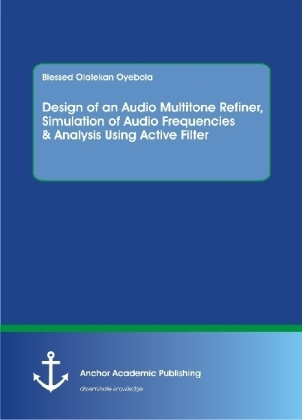
Design of an Audio Multitone Refiner, Simulation of Audio Frequencies & Analysis Using Active Filter
Anchor Academic Publishing (Verlag)
978-3-96067-135-0 (ISBN)
The work mainly focuses on improving an input audio signal to be free from shape glitch in order to circumvent unwanted audible peaks or anomalies in the final sound. Additionally, this study tries to offer operational flexibility per definition of an Audio Multitone Refiner.
Because of their versatility, the signal analyzing tools Laplace transform, Fourier series, D.C. and transient analysis were employed to ascertain the realization of all constructed circuits in this study. 'Casio fx7400G' language was used during programming of the band pass filter, as were active filters.
Text Sample:
Chapter 3. DESIGN:
The approach exploited here was rigorous and experimentation coupled with, mathematical analysis, programming/ computation- to -simply calculations-, circuit synthesis and simulation or modeling (see special comments below) with Butterworth filter response as the favourite standard in this study; however, multiple feedback band pass (MFB) Filter would be used (approximate) unit- gain frequency bandwidth.
Special Comment: the design package used here is limited in applications in that while it allowed some features to be exploited; it disallowed (subscript) others hence Vin (wherever it is seen in this write-up implies) Vi, likewise Va=Va R1=R1, R2=R2, R3=R3, C1=C1, C2=C2, and C3=C3. These were adhered to in the subsequent chapters expect in some cases where circuit models were properly drawn.
The input low frequency response signal needs to be defined. It is done once through C1 and Rin; to prevent a very saggy bottom end to the frequency response that might result using non inverting as the input a single series capacitor C1 and the bias resistor ( the equivalent op-amp input resistance ) parallel resonant together to limit the passable or allowable feed in frequency. While for the inverting type, there is series resonant between series C1 and a series input resistor R1, 3Db down at 5Hz, and 0.2Db down at 20Hz, which is definitely inside the audio band. The op-amp were so guided to ensure stable dc biasing round all its terminal hence high pass at about (5Hz) were placed the op-amp to steer tract its dc bias while that along the supplies were to maintain stability at high frequency and to filter distortion frequency in the supplies lines. Once the starting frequency 15Hz 'the necessary octave division and quality factor, Q to use for various frequencies bands had been determined, other frequencies could be factor, taken a crucial reference to main vocal frequencies using the expression : [...].
3.1 Filter Architecture:
The transfer function of MFB filter used was as depicted in the following analysis: [...].
Design Dimensioning Techniques:
The below program simply (see special comments in section 3.0) the component selection having or chosen MFB filter for this design, Table 3.1 shows the resulted valves which are critically chosen to the available component series (E12 and E24). This (program2) caters for various desired frequencies, capacitors and resistors in that order [...].
The op-amp were guided to ensure stable D. C. biasing round all its terminal hence high pass at about (5Hz) were placed around the op-amp to guide tract its dc bias while that along the supplies were to maintain stability at high frequency and to filter distortion frequency in the supply lines. Speech fundamentals occur over a fairly limited range between about 125Hz and 250Hz. Vowels essentially contain the maximum energy and power of the voice, occurring over the range of 350Hz to 2000Hz. Consonant occurring over range of 1500Hz to 4000Hz contain little energy but are essential to intelligibility. The frequency range from 63 to 500Hz carries 60% of the power of the voice and yet contributes only 5% to the intelligibility. The 500Hz to 1KHz region produces 35% of the intelligibility, when then from 1K to 8KHz produces just 5% of the power of 60% of the intelligibility, Table 3.1 shows various vocals and their effect on sound. This helps in mixer design.
Filter Design Techniques (James, 1997) Oblique:
1). The band filter section were 0dB at fc.
2). The design Q required for the desired bandwidths require a Q of 4.3185) without approximations, ISO approximations, that is for 793.7 it is not 800Hz.
Topology selection involved many trade-offs, but for special reasons MFB, type was preferred. The task was to design a second order unity gain filter with various corner frequencies. In addition, minimum phase behavior is an important criterion [...].
3.2 Op-Amp Selections and Blue Print
The most important opamp
| Erscheinungsdatum | 14.05.2017 |
|---|---|
| Sprache | englisch |
| Maße | 155 x 220 mm |
| Gewicht | 109 g |
| Themenwelt | Technik ► Elektrotechnik / Energietechnik |
| Schlagworte | Active Filter • Amplifier • Audio Filteration • Audio multi-tone refiner • Band Pass Filter • Low pass filter • Multiple feedback • Nachrichtentechnik • Tone control |
| ISBN-10 | 3-96067-135-0 / 3960671350 |
| ISBN-13 | 978-3-96067-135-0 / 9783960671350 |
| Zustand | Neuware |
| Haben Sie eine Frage zum Produkt? |
aus dem Bereich


